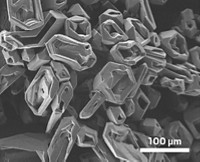Advertisement
Grab your lab coat. Let's get started
Welcome!
Welcome!
Create an account below to get 6 C&EN articles per month, receive newsletters and more - all free.
It seems this is your first time logging in online. Please enter the following information to continue.
As an ACS member you automatically get access to this site. All we need is few more details to create your reading experience.
Not you? Sign in with a different account.
Not you? Sign in with a different account.
ERROR 1
ERROR 1
ERROR 2
ERROR 2
ERROR 2
ERROR 2
ERROR 2
Password and Confirm password must match.
If you have an ACS member number, please enter it here so we can link this account to your membership. (optional)
ERROR 2
ACS values your privacy. By submitting your information, you are gaining access to C&EN and subscribing to our weekly newsletter. We use the information you provide to make your reading experience better, and we will never sell your data to third party members.
Materials
Mechanochemistry enables 17O labeling
Grinding reagents with isotope-enriched water reduces cost and time to get compounds ready for NMR
by Jyllian Kemsley
May 29, 2017
| A version of this story appeared in
Volume 95, Issue 22
Oxygen-17 NMR spectroscopy is one tool that chemists can use to study the structure and reactivity of various organic and inorganic compounds. But 17O’s low natural abundance—merely 0.04%—requires enriching samples with the isotope, a process that is often costly and time-consuming.
One solution to the challenge of 17O labeling may be mechanical: Combine a reagent with a stoichiometric amount of 17O-enriched water and grind the mixture in a ball mill, suggests a team led by Danielle Laurencin of the Institut Charles Gerhardt Montpellier (Angew. Chem. Int. Ed. Engl. 2017, DOI: 10.1002/anie.201702251).
Grinding reagents in a ball mill to induce reactions is a form of mechanochemistry that has gained popularity in recent years as a relatively quick and convenient way to make some organic and inorganic compounds. As the balls collide in the mill, effects such as shear stress and increased temperature may help stimulate chemistry at the interfaces between particles.
Laurencin and colleagues produced 17O-enriched metal oxides by combining a metal hydroxide with less than two equivalents of 17O-enriched water, grinding the reagents for 30 minutes, then heating the material to convert it to the metal oxide. Enriching 60 mg of Mg(OH)2 or Ca(OH)2 to 17O levels suitable for solid-state NMR analyses cost the team about $10.
For 17O NMR of organic compounds, the researchers focused on carboxylic acids, which frequently turn up in biomolecules and metal ligands, such as those in metal-organic frameworks. The researchers first ground the organic compounds with 1,1’-carbonyl-diimidazole to activate the carboxylic groups and then milled the material with 17O-enriched water. The whole procedure took less than two hours.





Join the conversation
Contact the reporter
Submit a Letter to the Editor for publication
Engage with us on Twitter